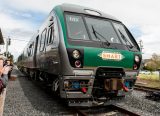Blog Post < Previous | Next >

SMART
Why is the SMART train so unsuccessful?
As someone who has done extensive analysis of the financial condition of the Sonoma-Marin Area Rail Transit (SMART) train, I decided to ask ChatGPT a simple question: "Why is the SMART train so unsuccessful?"
The following was its response.
The Sonoma–Marin Area Rail Transit (SMART) system has faced several challenges that have hindered its success since its inception in 2017. Here are the primary factors contributing to its struggles.
1. Low Ridership and Limited Impact
SMART's average weekday ridership has consistently fallen short of projections. For instance, in January 2020, it recorded just 2,847 weekday riders, a number that pales in comparison to other Bay Area transit systems . This limited usage means SMART has had minimal effect on reducing traffic congestion along Highway 101, with its annual passenger miles representing only a tiny fraction of the total vehicle miles traveled in the corridor.
2. High Operating Costs and Low Fare Recovery
Operating SMART is expensive. The farebox recovery ratio—the percentage of operating costs covered by passenger fares—is under 10%, significantly lower than systems like BART (73%) or Caltrain (66%) . This means that taxpayers subsidize the vast majority of the system's operating expenses. In the 2018-19 fiscal year, the taxpayer subsidy per boarding was about $33, which increased to $196 during the 2020-2021 period amidst the pandemic.
3. Inconvenient Station Locations and Limited Connectivity
Many SMART stations are situated away from major residential areas and employment centers, making them less accessible for potential riders. For example, in Santa Rosa, the average distance to a SMART station for the largest employers is 2 miles . Additionally, the system's integration with other transit options is limited. While there are some shuttle services and ride-share programs, full coordination with local transit agencies remains a challenge.
4. Infrastructure Limitations
SMART operates primarily on a single-track system with limited passing tracks, which restricts the frequency and flexibility of train services. This setup can lead to significant delays and limits the number of trains that can run simultaneously.
5. Financial Sustainability Concerns
The system relies heavily on a quarter-cent sales tax for funding, which is set to expire in 2029. A proposal to extend this tax for an additional 30 years was rejected by voters in 2020, reflecting public skepticism about the system's value and effectiveness.
6. Demographic and Regional Challenges
Sonoma and Marin counties have relatively low population densities compared to other regions served by commuter rail, limiting the potential ridership base. Moreover, population growth in these counties has been stagnant or declining, further constraining future ridership growth.
7. Delayed Implementation and Operational Hurdles
SMART's launch was delayed multiple times due to various issues, including equipment failures and infrastructure damage from natural events like floods . These delays not only increased costs but also eroded public confidence in the project.
In summary, SMART's challenges stem from a combination of low ridership, high operating costs, infrastructure limitations, and regional demographic factors. Addressing these issues would require significant investments and strategic planning to enhance the system's appeal and effectiveness.
